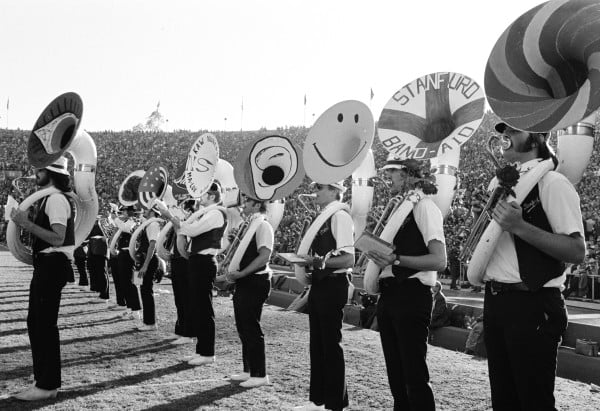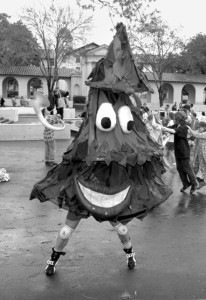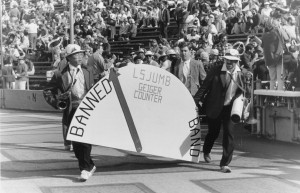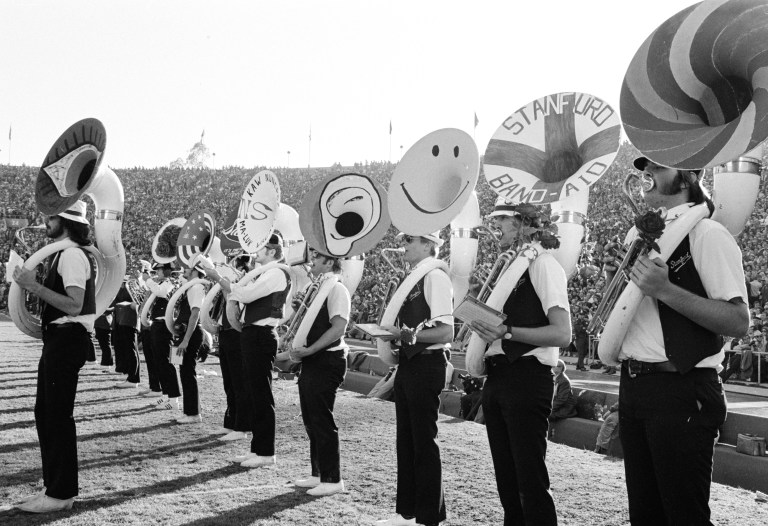Those familiar with the Band’s modern-day incarnation may be surprised to learn that Stanford’s most colorful student organization started off as a traditional all-male, Sousa-playing marching band, complete with in-step line formations and military uniforms.

Formed in 1893, the Leland Stanford Junior University Marching Band (LSJUMB) had all the makings of a typical college marching band. Turmoil arrived in 1963, however, when a reorganization of the music department resulted in the dismissal of long-time Band director Jules Schucat.
Enraged at the change, the bandsmen organized themselves to withhold their musical services in what became known as the Band Strike of ’63. At the first two football games of the season in the fall of 1963, the Stanford Band was conspicuously absent.
The reign of Dr. Barnes
Enter Arthur P. Barnes D.M.A. ’65, a former band and music theory instructor at Fresno State who had been tapped to replace Schucat as Band director while pursuing his doctorate in musical education at Stanford.
Gifted with perfect pitch and incredible musical talent, Barnes won the students over with his innovative and timely two-minute arrangements of their generation’s most popular rock ‘n’ roll songs and his laissez-faire attitude towards Band government. Effectively ceding all control of the Band to the students, Barnes focused instead on cultivating a musical repertoire that radically deviated from traditional marching music.
“We were the world’s largest rock ‘n’ roll band,” said David Ruiz ’73, who played trumpet in the Band and served as the Band’s assistant manager and later as manager. He recounts Band members bringing records and cassettes to Barnes, who would then translate, if suitable, the hits of The Rolling Stones and The Beach Boys into band music befitting every instrument section.
“We chose the music that resonated with us, that had cultural meaning,” Ruiz said. “The music reflected the organization’s composite — the people.”
Indeed, the Band’s present-day de facto fight song, “All Right Now,” was charted by Barnes following a student suggestion.
A little autonomy never hurt anybody
Barnes’ appointment ushered in a new era of a student-run Band, a modus operandi that has defined the culture of the Band to this day. Greg Louden ’89 M.A. ’90, chairman of the Stanford Band Alumni Board, likens Barnes to “the cool uncle, the one who helped you achieve what you wanted, but also let you do your own thing.”

“Dr. Barnes took control of the band by giving control to the students,” Louden added.
This newfound student autonomy was soon exhibited in the Band’s field shows, which quickly took on the distinct humor and tongue-in-cheek irreverence that to this day flavor the Band’s performances. In the transformative years following the Band Strike, students were not mandated to submit the music and scripts of their halftime shows for reviews and thus exercised considerable creative reign.
Hal Mickelson ’71, who served as stadium announcer for 15 years and established himself as an integral voice of the Band’s field shows, said that the Band focused on making formations that could fully illustrate the joke.
“By the time I arrived in 1967, the formations were the punch lines of jokes,” Mickelson said. “The combination of the visuals on the field and the song titles were like a single-panel cartoon.”
To facilitate the playing of music, band members began “scattering,” or running haphazardly between formations instead of marching in predetermined paths. According to GoStanford.com, LSJUMB is one of just 10 known scatter bands at Division I schools.
“Equal opportunity offenders”
Talk to any “Old Fart,” as Band alumni are affectionately called, and he or she will regale you with tales of most memorable Band antics and field shows past. A significant amount of these anecdotes display an obvious — if provocative — disregard for convention and decorum, a not-unexpected trend given the Band’s proclivity for bold and impudent statements.
Sam Boot ’70, who served as properties manager and played the trumpet in Band, recalled the 1970 Stanford-Arkansas football game, in which during a Beach Boys-themed half-time show, Stanford band members dropped their pants on national television to reveal surf jams underneath. Mickelson remembers announcing a “Death of Chairman Mao” show at an away game at Penn State following the death of the communist leader.
“I’d like to think we were narcissistically clever…equal opportunity offenders, if you will,” said Ruiz, who fielded his fair share of calls from disgruntled spectators during his time as manager.
Perhaps few know controversy as well as Louden, who served as drum major in 1990 during the Band’s infamous University of Oregon halftime show, which spoofed the spotted owl timber battle between the logging industry and environmentalists. Formations included a giant chainsaw and band members re-forming the word “OWL” to “AWOL” on the field. Following the inevitable backlash, the governor of Oregon attempted to ban the Band from the state of Oregon (he failed).

Louden noted the environment that the Band was operating in became much more restrictive in the 1990s, attributing the increasing cries of outrage to the growth of a more conservative society and the “politics of being offended.”
Though the Band was — and still is — no stranger to controversy, its alumni are quick to defend its sometimes-divisive antics, arguing that the Band’s intentions are often misconstrued and not politically charged.
“The Band is incredibly clever and slightly controversial and not specific as to whom we might offend,” Ruiz explained. “Truth is, most of the halftime shows and music were done by a volunteer group coming from all spectrums of society, from athletes to ROTC students. Band was a safe haven from life and its stressors, where we lost all sense of individual politics and religion and used our alter egos to express ourselves.”
The Band plays on
As the Band celebrates 50 years since the Band Strike of ’63, the red-blazer-clad, white-golf hat-sporting members of Band continue to carry on the carousing spirit and mischievous legacy of their predecessors.
Mickelson describes the evolution of the Band in the past 50 years as one of “breathtaking consistency.”
“The personalities of student organizations turnover fast when new people come over,” he explained. “What is remarkable and dazzling is that the personality of the band hasn’t changed at all. The same kind of jokes, humor, irreverence and attitude towards authority hasn’t changed. Band’s sense of humor has been consistent over 50 years.”
“Youth is for the youthful,” Ruiz said. “The band has continued to reflect the contemporary Stanford culture. The Band is what it is. It’s a reflection of Stanford whenever one happens to be in it, so it continues to accomplish its mission.”
Contact Minna Xiao at mxiao26 ‘at’ stanford.edu.
